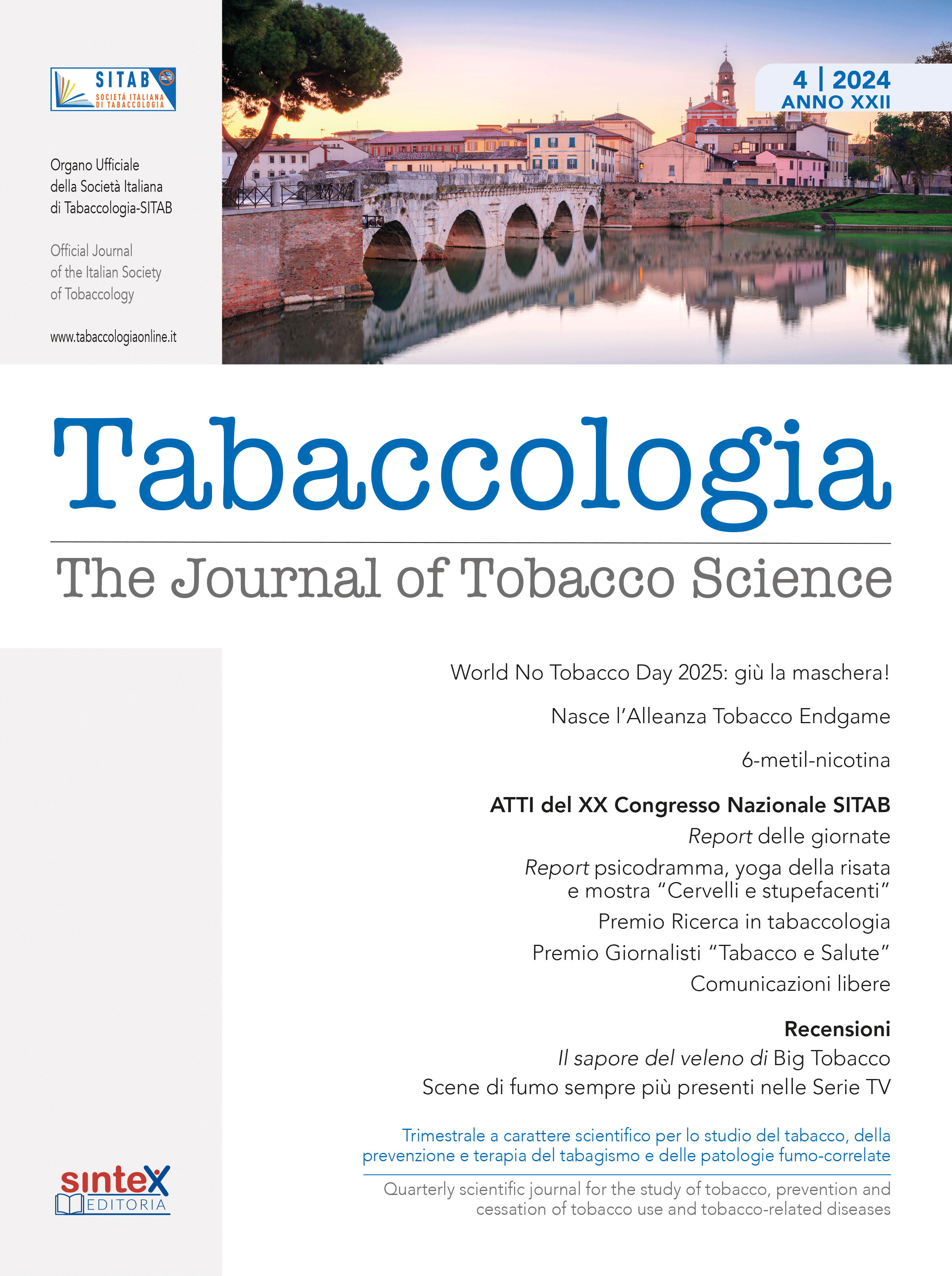|
Rassegna Stampa Scientifica Giugno 2022
|
Orticaria indotta da citisina: un caso clinico durante un trattamento per smettere di fumare
La notizia è relativa al recente articolo pubblicato sulla rivista Acta Biomedica (Acta Biomed 2022; Vol. 93, Supplement 1: e2022073) accessibile attraverso il link: https://pubmed.ncbi.nlm.nih.gov/35731167/
La citisina il più antico farmaco per smettere di fumare, utilizzata da oltre 50 anni nell’Europa dell’est e in Asia, è generalmente ben tollerata ed efficace. Gli eventi avversi riportati negli studi sono in genere disturbi gastrointestinali e del sonno, non gravi e autolimitanti. E’ stato recentemente pubblicato per la prima volta un caso sospetto di orticaria, in una donna di 48 anni in cura per tabagismo presso l'Unità di Medicina delle Dipendenze, Dipartimento di Medicina Interna, Azienda Ospedaliera di Verona, Italia1. Il protocollo terapeutico utilizzato per la cessazione dal fumo era quello standard che prevede l’aumento gradualmente delle capsule di citisina assunte giornalmente. La paziente ha sospeso la citisina, è stata trattata per i primi tre giorni con betametasone (1 mg/die) e ha mostrato segni di guarigione dopo una settimana.
Brain lesions disrupting addiction map to a common human brain circuit
Nature Medicine (2022)
Published: 13 June 2022
Juho Joutsa, Khaled Moussawi, Shan H. Siddiqi, Amir Abdolahi, William Drew, Alexander L. Cohen, Thomas J. Ross, Harshawardhan U. Deshpande, Henry Z. Wang, Joel Bruss, Elliot A. Stein, Nora D. Volkow, Jordan H. Grafman, Edwin van Wijngaarden, Aaron D. Boes & Michael D. Fox
https://www.nature.com/articles/s41591-022-01834-y
https://www.nature.com/articles/s41591-022-01834-y.pdf
A smoke-free generation: New Zealand's tobacco ban
The Lancet
VOLUME 399, ISSUE 10339, P1930-1931, MAY 21, 2022
Chris McCall
https://www.thelancet.com/journals/lancet/article/PIIS0140-6736(22)00925-4/fulltext
https://www.thelancet.com/action/showPdf?pii=S0140-6736%2822%2900925-4
Note: Open Access upon registration.
"Despite the current no-tobacco advertising policies, both PMI’s [Philip Morris International's] and Altria’s corporate image campaigns have run extensively in major news outlets (in both physical and digital formats), including the New York Times and Washington Post… They feature high-ranking corporate executives advocating for company-sponsored research coupled with claims that these companies are aligned with public health objectives. Message placement in prominent news outlets suggests a deliberate attempt to position their sponsored content alongside news reporting while helping to ensure message exposure among an influential audience… The extent to which these ‘corporate promotion’ ads have infiltrated major news outlets is concerning, raising questions about how objective media outlets should treat sponsored industry content."
Ad watch
Tobacco industry advertising: efforts to shift public perception of big tobacco with paid media in the USA
Tobacco Control Published Online First: 16 May 2022.
Robin Koval, Nicole Dorrler, Barbara Schillo
https://tobaccocontrol.bmj.com/content/early/2022/05/08/tobaccocontrol-2021-057189
"Our study demonstrates majority support for regulations controlling e-cigarettes in Australia. Parents generally favoured wide-ranging restrictions that could reduce adolescent e-cigarette use. Almost all parents support a ban on marketing and advertising of e-cigarettes to teenagers thus recognising the reach and influence of product appeal, placement and price on this age group. Australian governments have an opportunity to help prevent more widespread e-cigarette use and protect the health of adolescents by limiting their exposure to e-cigarette promotions."
Parents support strong restrictions controlling e-cigarette use in Australia: findings from a national survey
Tobacco Control Published Online First: 17 May 2022.
Mary-Anne Measey, Vikram Palit, Monsurul Hoq, Moya Vandeleur, Anthea Rhodes
https://tobaccocontrol.bmj.com/content/early/2022/05/16/tobaccocontrol-2021-057074
Also:
Analysis of mainstream emissions, secondhand emissions and the environmental impact of IQOS waste: a systematic review on IQOS that accounts for data source
https://tobaccocontrol.bmj.com/content/early/2022/05/12/tobaccocontrol-2021-056986
Place-based inequities in cigarette smoking across the USA
https://tobaccocontrol.bmj.com/content/early/2022/05/17/tobaccocontrol-2022-057293
"Due to the low return of saliva samples, validated prolonged abstinence rates in the intention-to-treat analysis were low (39 of 571 (6.8%) versus 25 of 569 (4.4%) in the e-cigarette and NRT [nicotine replacement therapy] arms, respectively) and did not differ significantly between the two study arms… In summary, in the unadjusted primary analysis there was insufficient evidence to confidently demonstrate that e-cigarettes are more effective than NRT in helping pregnant women to stop smoking. The effects of e-cigarettes appear to have been masked by e-cigarette use in the NRT arm. When abstinent participants using non-allocated products were excluded, e-cigarettes were markedly more effective than patches in all abstinence outcomes. "
Electronic cigarettes versus nicotine patches for smoking cessation in pregnancy: a randomized controlled trial
Nature Medicine (2022)
Published: 16 May 2022
Peter Hajek, Dunja Przulj, Francesca Pesola, Chris Griffiths, Robert Walton, Hayden McRobbie, Tim Coleman, Sarah Lewis, Rachel Whitemore, Miranda Clark, Michael Ussher, Lesley Sinclair, Emily Seager, Sue Cooper, Linda Bauld, Felix Naughton, Peter Sasieni, Isaac Manyonda & Katie Myers Smith
https://www.nature.com/articles/s41591-022-01808-0
https://www.nature.com/articles/s41591-022-01808-0.pdf
Note: Open Access.
Related coverage:
E-cigarettes ‘as safe as nicotine patches’ for pregnant smokers trying to quit
Vaping may be an effective way to quit smoking during pregnancy
"We did not find a significant difference in the cardiovascular risk of exclusive e-cigarette use compared with nonuse of cigarettes and e-cigarettes, although analyses were limited by a small number of CVD [cardiovascular disease] events in e-cigarette users. Dual use of cigarettes and e-cigarettes was associated with a significantly increased risk of CVD compared with nonuse. The cardiovascular risk of dual use did not differ from the risk among those exclusively smoking cigarettes."
Letter
E-cigarette Use and Risk of Cardiovascular Disease: A Longitudinal Analysis of the PATH Study, 2013-2019
Circulation. 2022;0
Originally published 6 May 2022
Jonathan B. Berlowitz, Wubin Xie, Alyssa F. Harlow, Naomi M. Hamburg, Michael J. Blaha, Aruni Bhatnagar, Emelia J. Benjamin and Andrew C. Stokes
https://www.ahajournals.org/doi/10.1161/CIRCULATIONAHA.121.057369
https://www.ahajournals.org/doi/epdf/10.1161/CIRCULATIONAHA.121.057369
Note: Open Access.
"We analyzed Global Adult Tobacco Survey data in Bangladesh, China, Costa Rica, Ethiopia, India, Kazakhstan, Mexico, Philippines, Romania, Russia, Senegal, Ukraine, Turkey, Uruguay, and Viet Nam during 2014–2018… EC [E-cigarette] use was low in most countries. “Dual use” was common among current smokers and the quit ratio was higher among ECs users… Nevertheless, comprehensive EC regulatory policies should be implemented to prevent the escalation of EC use by targeting population subgroups such as young adults, educated and wealthier individuals."
Awareness About and E-Cigarette Use Among Adults in 15 Low- and Middle-Income Countries, 2014–2018 Estimates From Global Adult Tobacco Surveys
Nicotine & Tobacco Research, ntab269.
Published: 21 May 2022
Chandrashekhar T Sreeramareddy, Anusha Manoharan
https://academic.oup.com/ntr/advance-article-abstract/doi/10.1093/ntr/ntab269/6590320
"Following JUUL’s removal of mint in November 2019, JUUL’s market share dropped from over 66% in Florida and the United States to 37.1% (Florida) and 55.1% (United States). In January 2020, the second leading brands were Puff Bar (15.0%) in Florida and Vuse (18.1%) in the United States. Mint market share decreased and share of all other flavor categories increased, particularly menthol and concept. Total ENDS sales increased in Florida but decreased in the United States. Average prices of ENDS devices decreased. Conclusions: While JUUL’s actions led to a decline in its sales, Puff Bar emerged and menthol and concept flavors experienced growth."
JUUL’s 2019 Removal of Mint-Flavored Pods and Changes to the Retail Environment of Electronic Nicotine Delivery Systems in Florida and the United States
Nicotine & Tobacco Research, ntac128.
Published: 15 May 2022
Jennifer Gaber, Doris G Gammon, Youn Ok Lee, James Nonnemaker, Brittany Young, Annice Kim, Lauren Porter
https://academic.oup.com/ntr/advance-article-abstract/doi/10.1093/ntr/ntac128/6586051
Also:
Adolescents’ understanding of smoking and vaping risk language: Cognitive interviews to inform scale development
https://academic.oup.com/ntr/advance-article-abstract/doi/10.1093/ntr/ntac127/6585952
Secondhand tobacco smoke and functional impairments in older adults living in the community
https://academic.oup.com/ntr/advance-article-abstract/doi/10.1093/ntr/ntac131/6586052
A randomized pilot of a tailored smoking cessation quitline intervention for individuals who smoke and vape
https://academic.oup.com/ntr/advance-article-abstract/doi/10.1093/ntr/ntac129/6586250
"How we define “current use” of tobacco and nicotine delivery products changes our estimates of how individuals transition to, between, and from different patterns of use. We show that the robustness of transition estimates to whether or not non-established users are included as current users and to different frequency-of-use threshold depends in part on whether low-frequency users are categorized as non-current users or as a distinct category. Our results emphasize the importance of intentional definitions of product use that reflect the larger goals of public health and tobacco control."
The impact of current tobacco product use definitions on estimates of transitions between cigarette and ENDS use
Nicotine & Tobacco Research, ntac132.
Published: 19 May 2022
Andrew F Brouwer, David T Levy, Jihyoun Jeon, Evelyn Jimenez-Mendoza, Luz María Sanchez-Romero, Ritesh Mistry, Rafael Meza
https://academic.oup.com/ntr/advance-article/doi/10.1093/ntr/ntac132/6589520
Also:
The unhealthy association between smoking, vaping, and other drug use
https://academic.oup.com/ntr/advance-article/doi/10.1093/ntr/ntac130/6588418
Note: Open Access.
"The hardening hypothesis suggests that tobacco control activities influence an individual’s ability to quit, and those who find it challenging to quit are those who remain smokers. Reviews and papers have attempted to demystify this hypothesis, and the debate continues. Adding to the continuing discussions, a recently-published umbrella and systematic review by Harris et al. (2022) strongly opposed the existence of the hardening hypothesis, after conducting a wide-ranging qualitative synthesis of the evidence pertinent to various hardening constructs and indicators. However, several key methodological issues may have ushered a deficient—or worse, unqualified—interpretation of the evidence base."
Correspondence
The Hardening Hypothesis – Further Testing is Still Required
Nicotine & Tobacco Research, ntac125.
Published: 13 May 2022
Isabella Steffensen, Red Thaddeus D Miguel, Julien Carlone
https://academic.oup.com/ntr/advance-article/doi/10.1093/ntr/ntac125/6585632
Referenced N&TR study:
Smokers increasingly motivated and able to quit as smoking prevalence falls: umbrella and systematic review of evidence relevant to the 'hardening hypothesis', considering transcendence of manufactured doubt
https://academic.oup.com/ntr/advance-article/doi/10.1093/ntr/ntac055/6542043
Note: Open Access.
"Ever/current [Hungarian] HTP [heated tobacco product] users presented misperceptions about the harms of HTPs, e-cigarettes, and NRT. They underestimated the potential health benefits of NRT and had distorted harm perceptions about HTPs and e-cigarettes. Public education about the relative harms of different nicotine and tobacco products is urgently needed."
Perceived harm of heated tobacco products, e-cigarettes, and nicotine replacement therapy compared with conventional cigarettes among ever and current heated tobacco users
Addict Behav Rep. 2022 May 16;15:100432. eCollection 2022 Jun.
Melinda Pénzes, Tamás Joó, Róbert Urbán
https://www.sciencedirect.com/science/article/pii/S235285322200027X
Note: Open Access.
"We analyzed data from Wave 3 (Sept-Dec 2019) and Wave 5 (Sept-Dec 2020) of a 2-year, 5-wave longitudinal study of young adults across six US metropolitan areas… Of W3 cigarette non-users (n=1693), 5.0% (n=85) initiated cigarettes at W5; predictors of initiation included younger age, lower perceived smoking risk, lifetime cigarette and e-cigarette use, and W3 e-cigarette use. Of W3 e-cigarette non-users (n=1522), 6.3% (n=96) initiated e-cigarettes at W5; predictors included younger age, less news exposure, lifetime cigarette and e-cigarette use, and W3 cigarette use. Conclusions: These findings underscore the need to address cigarette and e-cigarette co-use and related risk perceptions in prevention and cessation interventions."
Changes in cigarette and e-cigarette use among US young adults from before to during the COVID-19 pandemic: News exposure and risk perceptions as potential predictors
Tob Prev Cessat. 2022 May 6;8:18. eCollection 2022.
Breesa Bennett, Katelyn F Romm, Carla J Berg
Note: Open Access.
"In 2020, the prevalence of middle and high school students reporting “no” or “little” harm (vs. “some” or “a lot”) was 20.1% for e-cigarettes, 17.4% for hookahs, 14.6% for cigars, 13.5% for smokeless tobacco, and 11.0% for cigarettes. During 2016–2020, perceptions of “no” or “little” harm decreased for e-cigarettes, increased for cigarettes and smokeless tobacco, and exhibited nonlinear changes for hookahs. Discussion: Most youth are aware of tobacco product harms, but opportunities exist to educate youth about the harms of nondaily tobacco product use."
Tobacco Product Harm Perceptions Among US Middle and High School Students, 2016-2020
J Adolesc Health. 2022 May 19;S1054-139X(22)00386-X. Online ahead of print.
Emily Glidden, Nikki A Hawkins, Ahmed Jamal, Teresa W Wang
https://www.jahonline.org/article/S1054-139X(22)00386-X/fulltext
"The implementation of CEASE [Clinical effort against secondhand smoke exposure] in practices was influenced by the adaptability and complexity of the intervention, the needs of patients and their families, the resources available to practices to support the implementation of CEASE, other competing priorities at the practices, the cultures of practices, and clinicians' and office staffs' knowledge and beliefs about family-centered tobacco control."
A Qualitative Study of Factors Influencing Implementation of Tobacco Control in Pediatric Practices
J Smok Cessat. 2022 May 5;2022:4156982. eCollection 2022.
Emara Nabi-Burza, Jonathan P Winickoff, Jeremy E Drehmer, Maurice P Zeegers, Bethany Hipple Walters
https://www.hindawi.com/journals/josc/2022/4156982/
https://downloads.hindawi.com/journals/josc/2022/4156982.pdf
Note: Open Access.
"In the French context, the new plain packaging of tobacco products probably had an impact on smokers’ perception of tobacco by increasing the embarrassment they felt when they took out their pack of cigarettes in plain sight. It also influenced the motivation to quit smoking, and more generally, it could contribute to the denormalization of tobacco."
Plain packaging on tobacco products in France: Effectiveness on smokers’ attitudes one year after implementation
Tob. Induc. Dis. 2022;20(April):35
Anne Pasquereau, Romain Guignard, Raphaël Andler, Karine Gallopel-Morvan, Viêt Nguyen-Thanh
http://www.tobaccoinduceddiseases.org/pdf-146600-74381?filename=Plain%20packaging%20on.pdf
Note: Open Access.






















